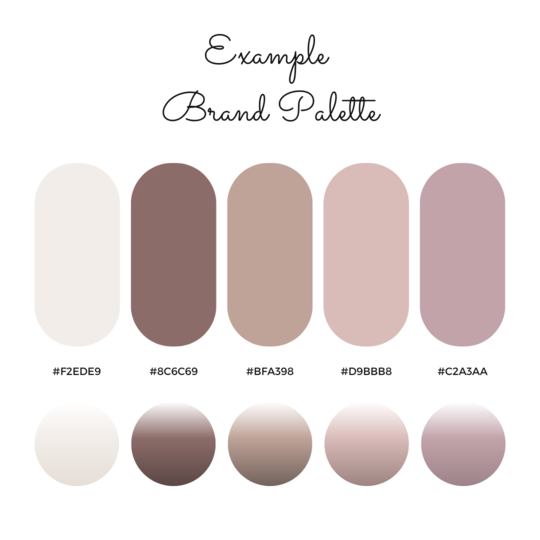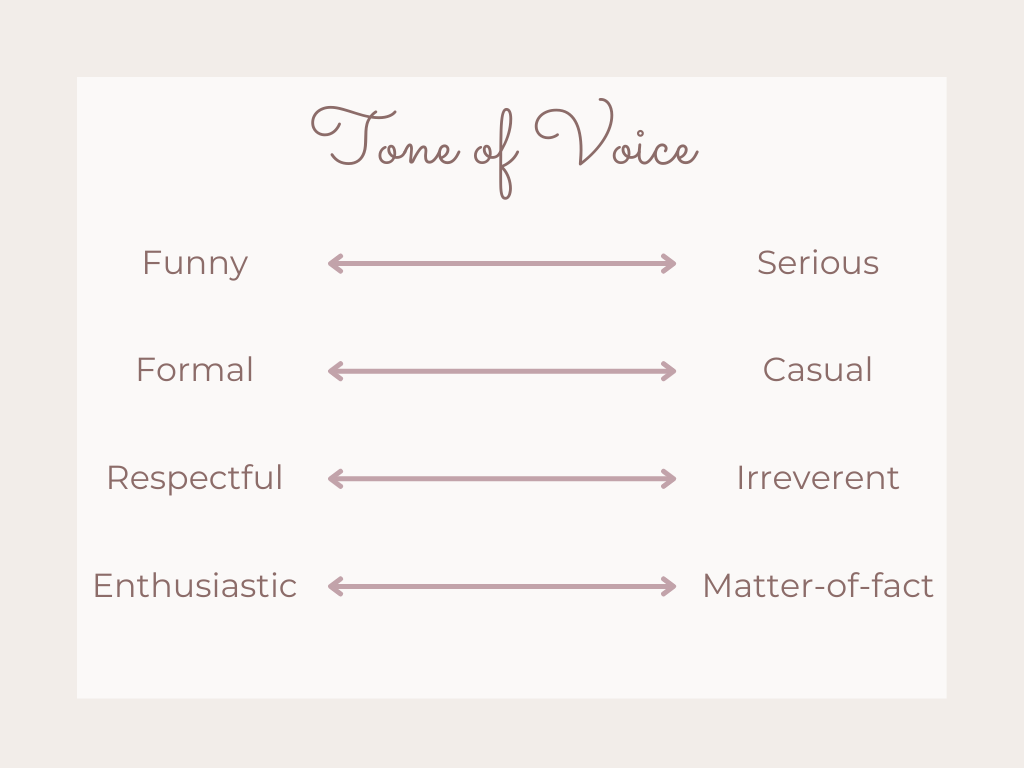How to Build a Brand as a Small Business in 3 Steps

This post uses affiliate links.
Do you want to learn how to build a brand as a small business? Understanding how to build a brand when starting a new business or expanding your current business, is central to your success.
To build a brand as a beginner you need to define the values, domain, assets and personality for your brand. That means learning the basics of branding.
In this article you will find all the information you need in order to build a brand, outlined in three steps:
Building a brand requires a large amount of work before actually starting to communicate it to your potential customers. So let’s get into it.
What is a brand?
Before learning how to build a brand as a small business, it is very important to know what a brand is. Contrary to common belief, a brand is not your logo. But your logo is part of your brand. We can define a brand as the following:
“A unique offer by the use of a name, symbol, design, packaging or similar, used to differentiate you (your business) from the competition.”
This means that everything identified with your business – is part of your brand. It can be your logo, your Instagram, your ecommerce shop and your brick-and-mortar store. Anything that you communicate to an audience about your business is your brand.
The key to the above statement – and the key to building a brand – is to understand the “unique offer” and “differentiate from the competition” parts. In this article I will go into detail about what this means and how it applies to your business when building your brand.
Why do you need a brand?
Now that we know that a brand is anything that can be associated with your business, it is important to understand why you need to build a brand.
What does a brand do?
A brand – or a strong brand – adds value in the minds of your customers. That means that if two companies sell the exact same product, but one company has a strong brand, their product will become more valuable. And thus more likely to sell than the company without a strong brand. A brand can add value in many ways but I will detail some of the most important ways in the list below.
Ways a strong brand adds value:
- Customers’ attitudes towards your products or services becomes more positive with a strong brand. And this translates to you making more sales.
- With a strong brand, you can increase the price of your products or services and make more profits.
- A strong well-known brand signals quality. Making the customers more likely to purchase your product over your competitors.
- A strong brand signals trust to your customers. It makes the customers more likely to purchase your product over your competitors.
- A strong brand also increases the financial value of your business
Can a small business build a brand?
So how does this apply to your small business? Isn’t building a brand for large corporations with enormous resources?
Yes and no. Most of the time large corporations will be difficult to compete with because of their strong brands. As a small business you cannot build a brand that is famous all over the world like Nike or Coca-Cola. But building a brand is still vital for you as a small business. In fact it is the only way you ever could compete with these global brand names. Because you are not a large corporation and that is something you can use to your advantage in your brand building. Focus on the strengths of a small business such as uniqueness, being local and familiarity. Position your brand on the other end of the spectrum from corporations. And attract customers that are looking for something else than mainstream products.
For example you can signal quality in your products by being hand-crafted or locally sourced. This separates you from mass produced products from China. Or you can add trust by being personal with the customer. They can meet and chat with the owner who made the product, instead of buying it from an impersonal store. Use your small size to your advantage when building your brand. That leads us to the next section:
How to build a brand as a small business
The million dollar question of how to build a brand starts in defining your brand. There are four main elements you need to consider when building a brand. These are brand values, brand domain, brand assets and brand personality. Don’t worry if you have no clue what these are as I will walk you through them in the upcoming section.
Brand value
Your brand values are the core values that your business stands for and its characteristics. If you haven’t already, you need to decide what values you want to portray with your business. As a small business this is often quite easy to do. Since the core values of your business often aligns with what your personal values are. While the values can be global issues in regards to politics, social issues or sustainability it by no means has to be. The brand values are those that drives your business. The values you would tell your (future) employees to portray to customers. It can be values such as integrity, responsibility or to treat every customer like a friend. These types of values are also described as characteristics such as quality, innovative and compassionate.
When you set the values make sure that they are values you truly believe in and not what you think your customers want. Because if you don’t believe in your brand why would anyone else, let alone a customer?
Brand domain
The brand domain is the target market you want to operate on. This entails the geographic location of your business and your target audience. If you have not defined your target audience yet, I recommend you read my article about target market analysis for small businesses. Knowing who your target audience is, is important when building a brand. But it is also vital for all your marketing and for the success of your business.
Defining your brand domain is not only about your current geographical location and your current customers. It is also about where your business is headed. Which geographical locations do you want your brand to exist on? And which are the target customers you want for your business? Knowing this is important in the rest of the brand building process. You don’t want to build a brand that becomes obsolete when your business starts growing. If your business goals are to expand into other locations or target another more audiences, you want to think about this when defining your brand. There might be certain elements that connects well with your local market but does not resonate with your future market. Defining your brand domain helps to ensure that you build a brand that lasts over time. As I am sure you have understood by now, building a brand is no easy task and it would be a shame if you had to change and rebuild it in the future.
Brand assets
To succeed with branding you also have to take into consideration competing businesses and brands. That is where your brand assets come in. Brand assets is what separates your brand from competitors on the market.
Brand assets consists of two main elements. What makes your brand unique and how your brand is positioned relative to competitors. Let’s break down what this means for you and how you can start defining your brand assets.
What makes your brand unique is often referred to as your Unique Selling Point or USP. Your USP is what makes your product or service better than competitors. It is the essence of what your business does best. And what you can offer the customers that other businesses cannot. The main question you should be asking when defining your USP is: ‘What makes you different from the competition?’. To help define the one main selling point that is your USP, start by making a list. Brainstorm at least 10 things that makes your business different from the competition. Make sure to take into account the two previous steps you have done; the brand values and brand domain. Then choose the most important one or combine a few of the most important ones into one sentence. Defining the USP is not only important for branding but to perform any type of effective marketing.
Once you have defined your USP you need to define what position your brand is going to have on the market. You need to identify your competitors and decide where your brand is positioned relative to their brands. Differentiating your brand from theirs.
To do this in a simple way, find three of your main competitors. Look at what they are doing and ask yourself the following questions in regards to each of the three competitors:
- What are their respective USPs?
- Why would someone buy my product or service instead of theirs?
- Is my USP different enough from the competitors’ that a customer would recognize the difference?
Answering these three questions should give you a fair idea of what your brand’s position is relative to the competition. If you find that your USP is not that different from the competition, you have to change it. If this all seems very abstract, I will give you an example to make it more concrete.
Say you operate a flower shop, selling flower arrangements to weddings. Next door you have a flower shop selling funeral flower arrangement. The difference between the two brands is very clear to any passers-by. But if the flower shop next door also specializes in weddings you need to make the difference between your shops more clear. You need to position your brand in relation to what this other flower shop is doing. If the competitor specializes on formal weddings with classical arrangements. Then you can position your brand as more natural, using wild flowers and a bohemian style.
You need to decide how you want to separate your brand from the competition. Making the difference crystal clear to any potential customer. Your brand values and your brand domain should help with this. But the next step, brand personality, can help you differentiate your brand further.
Brand personality
Brands are often associated with characteristics similar to human personality traits. With successful branding the customers see the brand as an extension of themselves. Or they see the brand as something they aspire to be. This is the brand personality and it can help you create a deeper relationship with your customers.
Brand personality is defined in five dimension, according to Aakers brand personality model. The five dimensions are sincerity, competence, excitement, sophistication and ruggedness. These dimensions can then be further detailed as seen in the image below.

When defining your brand personality you should choose a limited number of these traits and assign them to your brand. Perhaps your brand is down-to-earth, outdoorsy and daring. Or it is unique, glamorous and successful. Or it is real, young, cool and tough. Using these five dimensions and the subcategories you can make up an endless amount of personality combinations. Identify the most significant traits that symbolizes your brand values and brand assets. And that connects with your target audience. It is also important to consider what personalities your competitors have.
Now the flower shop example makes more sense. If the other flower shop has a personality that is sincere, contemporary and upper-class. Your brand could take the position as family oriented, exciting and charming.
Adding it together
After performing these exercises, you should have a clear idea of what your brand is. Don’t decide on the above four brand factors a step-by-step order. Consider them simultaneously so that they all are in harmony with one another. And defining them all will ensure you have a great foundation when moving on to the next step of how to build a brand.
How to build a brand graphic profile that reflect your brand
Before you start communicating your newly defined brand, with its values, assets and personality traits. It is important to create all the tangible elements for the communication of your brand.
Every brand needs a graphic profile, which consists of three main elements. The color palette, typefaces and logo. If you are not a graphic designer or know little of graphic design, this can seem a little intimidating. But do not worry, there are plenty of simple tools out there that can help you. Below you will find the most important factors to consider when creating these three elements.
But before you create a graphic profile for you brand you need to start thinking about your brand name.
Coming up with your brand name
If you do not have a name for your brand yet, here are some things to consider when deciding your brand name.
- It should be simple and easy to pronounce – so that new customers can easily remember it
- It should feel familiar or meaningful in regards to the product or service you are selling. It should make sense and be relevant for your offer.
- Symbolize the emotions you are trying to create with your brand. Make the name relevant to the brand personality.
- You can use analogies by breaking down your product category and combining it with an adjective. Such as ‘Fabletics’, combining ‘fabulous’ and ‘athletics’.
- Make sure to look up if the name is trademarked, or if it means something else in a different language.
Creating your brand palette
The brand palette is the colors you are going to use for your visual communications. On your website, logo, ads and social media posts. It is important that the brand palette reflects your brands values and personality. Every color reflects different emotions and values that you can use to reflect your brand. In the image below you can see what meaning the different colors have. If you do not have experience with graphic design and don’t know how colors work together, Adobe has a great tool where you can create your own color palette. In this tool you can choose one main color and then the tool generates matching colors that creates a good palette.

Choose your brand fonts
To make sure you are consistent with your brand, it is not only the colors that needs to be cohesive with your brand. You also want to choose a combination of fonts that you will use in all communication. Choosing fonts can be very difficult because there are so many to choose from. If you don’t have an eye for design it can be tricky to combine different ones to decide your brand fonts.
A good way to structure your font decision is to decide on 2-3 different fonts that creates contrast. That can involve choosing a bold sans serif font in combination with a light serif font. Or a cursive script (handwriting) font with a sans serif font. When choosing fonts, the most important factor is that the fonts are legible. No matter how pretty your fonts are, they need to be easy to read.
There are millions of typefaces and finding, and combining, the right ones can be time consuming and difficult. Especially if you do not know any basics of graphic design. A great tool you can use to help with this process is Canva. They have many font sets that you can choose from and get inspired by. They also have color palette combinations with font sets.
Creating your brand logo
By now, you should have learned that your brand is not your logo. But the logo is still an important part of building a brand. It is the main visual element that your customers will remember you by. So it is important that it reflects your brand well. Again, Canva can be very useful when creating your logo. They have many logo templates you can use and customize to fit your own brand.
But if you are looking for something more original. And do not have the skills to create it yourself, consider paying a graphic designer. If you are serious about your brand, I recommend getting a professional to help. It will save you so much time and effort – and the result will most definitely be better. And it does not need to cost a fortune. Nowadays there are plenty of services out there where you can contact freelancing professionals. Fiverr is one of those, where it is easy to find a graphic designer and you can decide how much you want to spend. On Fiverr you can find graphic designers to help you with your entire graphic profile so you don’t need to worry about it.
How to communicate your brand
After performing the above steps you now have a solid brand to start communicating.
Defining your brand and creating the graphic profile is the most important and difficult tasks of building a brand. But the journey does not stop there. When you have created the brand, you need to communicate it with current and potential customers. After all, the point of creating a brand is to build a larger and more loyal customer base.
Marketing strategy
To communicate your brand effectively to new or existing customers, you need to create a marketing strategy. Building a brand is only one part of your marketing strategy and it is vital that you consider the other parts. In short terms, that means understanding your customer. And setting business and marketing goals. In this article I will not get into the depths of creating a marketing strategy. But if you want to learn more about this, check out my article on 5 Small Business Marketing Tips. Instead, you will find some specific communication tips when it comes to building brand awareness.
Tone of voice
You need to ensure that all your communication has the same style and portrays the brand. Whether you or someone else in your business creates the communications, it is important to have a ‘tone of voice’. Tone of voice is the way you phrase your communication, meaning it is not what you say but how you say it.
Defining your brand’s tone of voice makes sure that the brand is reflected in every piece of content you create. An easy way to define your tone of voice is to use NN Group’s four tone of voice dimensions as shown in the image below. Relating the four dimensions to your brand personality, will help define the tone of voice.

Create content not promotions
To build your brand in the mind of the potential customers you need to create branded content. Branded content involves creating communications that have editorial qualities. It creates interest and curiosity on a deeper level. The purpose of branded content is to create liking and clarity of what the brand represents. Not to generate sales. This type of content, as opposed to promotional content, creates value for the long term.
Branded content can involve content of educational, entertaining or inspirational character. It aims to make the customer want to consume your communications.
Use social media to build your brand
The easiest way to build brand awareness and create branded content is through social media. On social media consumers follow brands for the educational, inspirational or entertaining value they provide. Therefore, you need to create a social media strategy. You can read about this more in the article Small Business Social Media Marketing.
Tying it all together: How to build a brand
‘Consistency is key’ is a phrase you will hear across all forms of marketing. It is especially important when building a brand. All your communication, no matter format or medium, need to be consistent with your brand. This means that the message always must stay true to your brand. That is the brand values, brand domain, brand assets and brand personality. Always use your graphic profile and tone of voice, in every piece of content you create. Before you publish content always make sure to think about how it helps instill your brand in the mind of the customer.
If you take all the steps outlined above, you will have a solid foundation when building a brand. Remember that building a brand takes a long time. It is important that you keep up your communication continuously, to reinforce your brand. Then you will build brand awareness. And ultimately brand loyalty, getting more customers that are loyal to your business.
I hope this article has helped answer your question of ‘how to build a brand’!
Please share this article with someone you think will benefit from it, if you found it useful.

I'm Emma Ellinor
I’m a digital marketer, project manager and retail analyst.
For the past 7 years I have immersed myself into the field of marketing and management. I am on a mission to inspire more women to take their business to the next level. By sharing my journey to escape the 9-5 trap along with useful marketing, time management and small business tips.
